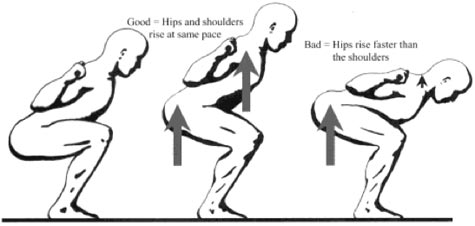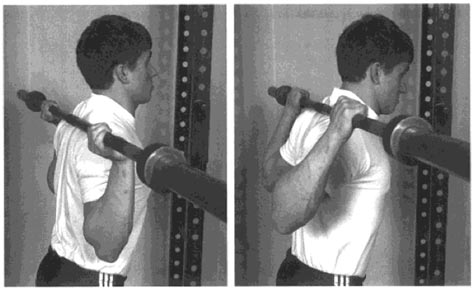Starting Strength
Barbell Bible
A barbell is the best training tool an athlete can use. The weight can vary from 10 lbs to over 1000 lbs in increments as small as 1/2 lb, and the set of available exercises is limited only by the lifter’s imagination. This makes training with a barbell suitable for pretty much anyone, regardless of age, sex, or experience.
Studies detailing injury rates show weight training to be as much as orders of magnitude less likely to cause injury than sports like running, cycling, football, and especially the most dangerous sport in America: soccer.
It can help prevent injuries by strengthening joints and bones, and creating more resilient tissues. With judicious use it can speed recovery from injuries that do occur. And it has even been shown to be effective in treating nagging ailments like back pain and certain kinds of arthritis. Being stronger also makes ordinary tasks much easier to accomplish. Everything from bringing in the groceries to playing with your kids to getting out of bed in the morning becomes easier as you get stronger. All of which means weight training may even be safer than not training at all.
That’s all great, but there’s a catch. Training with barbells has a skill component. To get the maximum benefit with minimum risk it’s best to understand and use good technique. But even before the invention of machine-based “health clubs” in the ’70s, instruction in the barbell lifts was best described as questionable, and most exercise instruction from luminaries like Bill Star and Mel Siff assumes proficiency with the barbell and works to create programs to allow people to continue to get stronger, or simply pushes people toward the “easy to use” but mostly useless machines.
With their book Starting Strength, Mark Rippetoe, a strength coach with almost 30 years experience in teaching novice lifters and a former competitive powerlifter himself, and Lon Kilgore, a competitive weightlifter and associate professor of kinesiology at Midwestern State University, are working to provide that missing information.
They cover five basic lifts — squat, bench press, deadlift, overhead press, and power clean — in amazing, well-illustrated, and readable detail. The chapter on the squat spans over 60 pages and covers not only technique but why to squat and how to identify and fix problems as they come up. The other exercises are covered in no less impressive detail, including some stellar and original thinking on the deadlift, and an effective basic training program to put everything together.
The authors even deal with such fictions as “squats hurt your knees” and “lifting weighs will make you bulky.” The simple answers to those objections are that if your knees hurt when you squat, you’re squatting wrong (or you have an existing injury), and that getting “hyooge” takes years of hard training, big eating, and, for many men and nearly all women, anabolic supplementation — i.e. steroids.
The now-out-of-print first edition was geared toward coaches, but because of the book’s cult popularity the second has shifted focus to self-instruction. Much of the book was rewritten to this end. It also includes an additional 100 or so pages on supplementary lifts and updates to the introductory weight training program.
I bought the first edition in the spring of 2006 and after a couple years using it, and now the expanded edition, to teach myself and friends and family to lift, I’ve found I don’t agree with the authors on some technical details of certain lifts. But without this book I wouldn’t have gained the knowledge to make those kinds of judgments.
As a budding Olympic-style weightlifter and former competitive cyclist, it’s the best $30 I’ve ever spent toward my training. And from Amazon to specialty weight training sites like EliteFTS, the reviews of this book are universally positive.
Save whatever you were going to spend on sports drinks over the next few weeks and buy this instead. It’s one of those books that belongs in everyone’s library.
11/19/10Excerpt

The back angle during the drive up form the bottom [of the squat] is critical to the correct use of the hips. The correct angle is produced when the bar is just below the spine of the scapula and directly vertical to the middle of the foot, the back is held tight in lumbar and thoracic extension, the knees are parallel to the correctly-placed feet, and the correction depth is reached, as discussed later.
*

Incorrect (left) and correct (right) use of the hands and arms. Elbows should be elevated to the rear with the hands on top, not placed directly under the bar where they intercept part of the weight.
*
The vast majority of people will prefer to grip the bar with the thumbs-around grip. At lighter weights, this is fine since the load presents no problems to keep in place. But when heavier weights are being used -- and, theoretically, they eventually should be -- the thumbs can create problems.
The thumb should be placed on top of the bar, so that the wrist can be held in a straight line with the forearm. Most people have a mental picture of the hands holding up the weight, and this usually ends up being what happens. The bar sits in the grip with the thumbs around the bar, the elbows end up directly below the weight, and nothing really prevents the bar from sliding down the back from this position. People that do this will have sore elbows, a horrible, headache-like soreness in the inside of the elbow that makes them think the injury occurred doing curls. If the elbows are underneath the weight, the force of the weight is straight down (the nature of gravity is sometimes inconvenient), then the wrists and elbows will intercept some of the weight. With heavy weights, the loading is quite high, and these structures are not nearly as capable of supporting 500 lbs, as the back is. If the thumb is on top of the bar, the hand can assume a position that is straight in line with the forearm, wrist, and hand, and all of the weight is on the back. A correct grip can prevent these problems before they start. If you learn to carry all of the weight of the bar on the back before your strength improves to the point where the weight becomes a problem, you'll have no problem at all.
Starting Strength Mark Rippetoe and Lon Kilgore 2011, 3rd Edition, 347 pages $30








